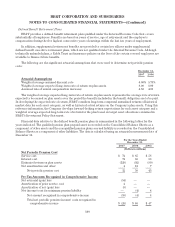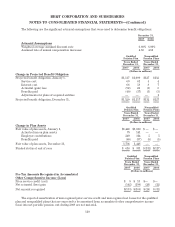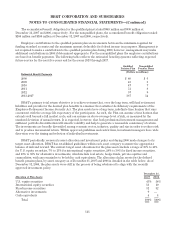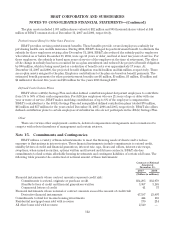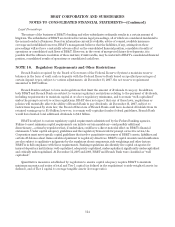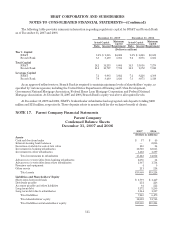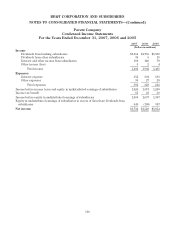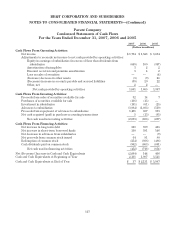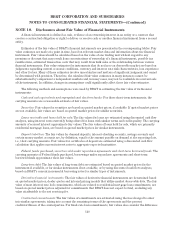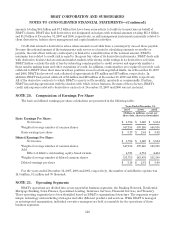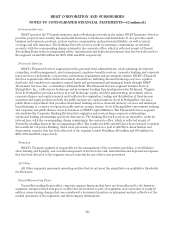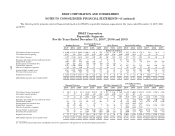BB&T 2007 Annual Report Download - page 118
Download and view the complete annual report
Please find page 118 of the 2007 BB&T annual report below. You can navigate through the pages in the report by either clicking on the pages listed below, or by using the keyword search tool below to find specific information within the annual report.BB&T CORPORATION AND SUBSIDIARIES
NOTES TO CONSOLIDATED FINANCIAL STATEMENTS—(Continued)
NOTE 18. Disclosures about Fair Value of Financial Instruments
A financial instrument is defined as cash, evidence of an ownership interest in an entity or a contract that
creates a contractual obligation or right to deliver or receive cash or another financial instrument from a second
entity.
Estimates of the fair value of BB&T’s financial instruments are presented in the accompanying tables. Fair
value estimates are made at a point in time, based on relevant market data and information about the financial
instrument. Fair values should be calculated based on the value of one trading unit without regard to any
premium or discount that may result from concentrations of ownership of a financial instrument, possible tax
ramifications, estimated transaction costs that may result from bulk sales or the relationship between various
financial instruments. Fair value estimates for instruments that do not have an observable market are based on
judgments regarding current economic conditions, currency and interest rate risk characteristics, loss experience
and other factors. Many of these estimates involve uncertainties and matters of significant judgment and cannot
be determined with precision. Therefore, the calculated fair value estimates in many instances cannot be
substantiated by comparison to independent markets and, in many cases, may not be realizable in a current sale
of the instrument. In addition, changes in assumptions could significantly affect these fair value estimates.
The following methods and assumptions were used by BB&T in estimating the fair value of its financial
instruments:
Cash and cash equivalents and segregated cash due from banks: For these short-term instruments, the
carrying amounts are a reasonable estimate of fair values.
Securities: Fair values for securities are based on quoted market prices, if available. If quoted market prices
are not available, fair values are based on quoted market prices for similar securities.
Loans receivable and loans held for sale: The fair values for loans are estimated using discounted cash flow
analyses, using interest rates currently being offered for loans with similar terms and credit quality. The carrying
amounts of accrued interest approximate fair values. The fair values of loans held for sale, which are primarily
residential mortgage loans, are based on quoted market prices for similar instruments.
Deposit liabilities: The fair values for demand deposits, interest-checking accounts, savings accounts and
certain money market accounts are, by definition, equal to the amount payable on demand at the reporting date,
i.e., their carrying amounts. Fair values for certificates of deposit are estimated using a discounted cash flow
calculation that applies current interest rates to aggregate expected maturities.
Federal funds purchased, securities sold under repurchase agreements and short-term borrowed funds: The
carrying amounts of Federal funds purchased, borrowings under repurchase agreements and short-term
borrowed funds approximate their fair values.
Long-term debt: The fair values of long-term debt are estimated based on quoted market prices for the
instrument if available, or for similar instruments if not available, or by using discounted cash flow analyses,
based on BB&T’s current incremental borrowing rates for similar types of instruments.
Derivative financial instruments: The fair values of derivative financial instruments are determined based
on quoted market prices, dealer quotes and internal pricing models that utilize market observable data. The fair
value of most interest rate lock commitments, which are related to residential mortgage loan commitments, are
based on quoted market prices adjusted for commitments that BB&T does not expect to fund, excluding any
value attributable to the net servicing fee.
Contractual commitments: The fair values of commitments are estimated using the fees charged to enter
into similar agreements, taking into account the remaining terms of the agreements and the present
creditworthiness of the counterparties. For fixed-rate loan commitments, fair values also consider the difference
118



